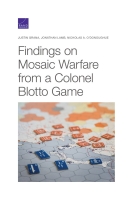by Justin Grana, Jonathan Lamb, Nicholas A. O'Donoughue
Is Mosaic warfare better (i.e., more cost-effective and robust) than more-monolithic approaches to conflict?
What are some of the key trade-offs of adopting a Mosaic force?
Can we gain any insight into the benefits of Mosaic warfare from competitive games?
RAND researchers explored the capabilities and limitations of future weapon systems incorporating artificial intelligence and machine learning (AI/ML) through two wargame experiments. The researchers modified and augmented the rules and engagement statistics used in a commercial tabletop wargame to enable (1) remotely operated and fully autonomous combat vehicles and (2) vehicles with AI/ML–enabled situational awareness to show how the two types of vehicles would perform in company-level engagements between Blue (U.S.) and Red (Russian) forces. Those rules sought to realistically capture the capabilities and limitations of those systems, including their vulnerability to selected enemy countermeasures, such as jamming. Future work could improve the realism of both the gameplay and representation of AI/ML–enabled systems.
In this experiment, participants played two games: a baseline game and an AI/ML game. Throughout play in the two game scenarios, players on both sides discussed the capabilities and limitations of the remotely operated and fully autonomous systems and their implications for engaging in combat using such systems. These discussions led to changes in how the systems were employed by the players and observations about which limitations should be mitigated before commanders were likely to accept a system and which capabilities needed to be fully understood by commanders so that systems could be employed appropriately.
This research demonstrated how such games, by bringing together operators and engineers, could be used by the requirements and acquisition communities to develop realizable requirements and engineering specifications for AI/ML systems.
Key Findings
A Mosaic force has the potential to exploit asymmetries in the resource allocation of an opposing force that is more monolithic (meaning that it allocates its force as larger units)
A Mosaic force can exploit asymmetries in the strategy employed by an opposing monolithic force, but this advantage decays as force size grows.
Asymmetries persist when platforms are subject to random failure. The dominant effect of random platform failure is a reduction in expected total force size, but if total force size is small, the Mosaic force can tolerate higher failure rates.
When there are multiple capabilities and individual battlefields respond differently to them, the Mosaic force's ability to exploit asymmetries in a more monolithic force persists, regardless of total force size.
Game theory can be a useful tool for studying the relative utility of Mosaic warfare and more-monolithic force allocation strategies, athough additional work is needed to increase the complexity and realism of the games presented in this report
Recommendation
Conduct additional studies that add complexity to the games used in this study. These enhancements could include battlefield payoff functions informed by real-world kill chains and targets, complex force structures with a mix of fractionated and aggregated platforms of varying degrees, and more-realistic models of capabilities, including some with reusability (e.g., sensors) and some with a limited magazine (e.g., missiles and bombs).

No comments:
Post a Comment